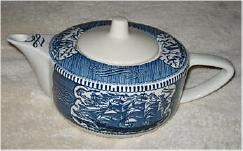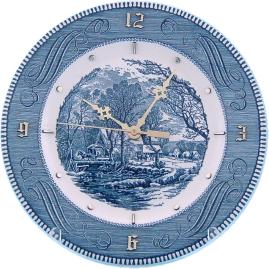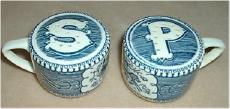National Depression Glass Association
Preserving America's Glass Manufacturing Heritage
Currier & Ives Dinnerware
by Debbi Irwin, North Carolina
Currier and Ives is a line of dinnerware being seen more and
more at shows, shops and antique malls. Many pieces of this pattern
were made by Royal China Company of Sebring, Ohio. Backstamped
marks include Royal China, Jeanette, Americana and USA, with some
pieces bearing no  mark at all. Also, calendar plates were
produced from 1972-1986 with the typical blue and white scroll
border.
mark at all. Also, calendar plates were
produced from 1972-1986 with the typical blue and white scroll
border.
An extensive list of items were produced in the Currier and Ives design. Some of the more rare and unusual pieces include tabbed handle and angle tabbed handle casseroles, tea pot, tidbit server, egg dish, a cereal with tabbed handle, a snack plate and others.
Other pieces with the Currier and Ives design were produced by Anchor Hocking and Glasbake (McKee). The Anchor Hocking pieces usually only have a mold number imprinted on the bottom. A knowledge of Anchor Hocking molds will help the shopper identify these pieces. Included in the Anchor Hocking line are cereal bowls, mugs, ovenware and mixing bowls. Glasbake pieces include ovenware pieces and can bear the Glasbake name on the bottom.
Webmaster's Note: The above article by Debbi Irwin was taken from the publication "Glass and More, May 1998" with permission from the publisher, Dr. Leonette Walls.
by Eldon R. Aupperle, Sebring, Ohio
Difficult pieces are always a challenge to collectors when the easy pieces cease to be on the "want list" and only the "seldom seen" ones are left to be found. Exercise patience! That is the best advice I can give when looking for those "hard to find" items. Taking the time and practicing the patience of searching for these hard items, in my opinion, brings a greater self satisfaction when the find is made.
 Probably the most sought after Currier &
Ives piece is the clock plate (at right). To my knowledge, within
the possessions of over 300 Currier & Ives Dinnerware Collector
Club members, less than a dozen have surfaced. There are electric
and battery powered, blue and pink, those fastened to a 10" dinner
plate and a 12" chop platter. The "book price" is $160-$180 for the
factory-made clock plates. Non-factory clock plates garner between
$32 and $40. One of the best ways to distinguish the difference is
that the factory-made ones have the numbers under the
glaze.
Probably the most sought after Currier &
Ives piece is the clock plate (at right). To my knowledge, within
the possessions of over 300 Currier & Ives Dinnerware Collector
Club members, less than a dozen have surfaced. There are electric
and battery powered, blue and pink, those fastened to a 10" dinner
plate and a 12" chop platter. The "book price" is $160-$180 for the
factory-made clock plates. Non-factory clock plates garner between
$32 and $40. One of the best ways to distinguish the difference is
that the factory-made ones have the numbers under the
glaze.
The candle (hurricane) lamp has probably drawn the most attention recently. This is because few have been found and there is a great desire to own them. Recently, a pair sold for over $1,500.00 on the internet. Some bases have been found at garage sales for fifty cents. The price fluctuates greatly. The globe (2 7/8" base diameter) can be purchased for around $6.00. To the best of my knowledge, the majority of these candle lamps have been found east of a north-south line drawn through Columbus, Ohio. Of those found thus far, there are two different shapes of the globes which have been verified in print.
Two chop platters, 11" ("the Rocky Mountains") and 13" ("A snowy morning") are very much in demand. Since there is a short supply and a strong demand, the going price is somewhat higher than that listed in the book.
The sweet server and tidbit server are factory-made and home-made. Basically, the factory-made plates or platters do not have any unglazed chips on the underneath side. There have been three styles of the sweet server collected:
- a single 13" chop platter
- a two-tier server
- a three-tier server
The majority of these have been found in the southeastern part
of the U.S. Also, either pink or blue dinnerware was used. There
 are
two types of hardware for the tidbit server - the teardrop (newer)
and circular shaped (older) tops.
are
two types of hardware for the tidbit server - the teardrop (newer)
and circular shaped (older) tops.
The 9" snack plate with the cup well has been found in blue and pink. The handle of the cup is scrolled. Even though the book price is $60.00, the pink has sold in excess of $100.00 at the C & I Dinnerware Collectors Club auction.
Bowl, cereal/salad, tab-handle, 6 3/8" is on the hard-to-come-by list. The blue is more available than the pink.
The mug ("the Express Train") and the coffee mug ("Fashionable Turn-outs in Central Park") make the most collectible list. The latter is somewhat larger than the regular cup and was manufactured earlier than the taller, heavier mug.
Several of the pieces were made with tab handles. Two of these are the covered casserole and the gravy boat. The go-along white tab handle under plate for the gravy boat is also difficult to find.
We call the two styles of covered butter "summer" and "winter" due to the nature of the print. Both have the same "winter" bottoms. Some day I hope to find one with the "summer" bottom. This does exist in the Memory Lane pattern.
Two other items which collectors would buy immediately are the trivet (6" x 6" tile) and the Recipe Booklet, A&P, 32 pages. Only a couple of each have surfaced.
Again, the self satisfaction of discovering your hard-to-find piece of dinnerware is well worth the wait if you can cultivate the patience to do so.
Webmaster's Note: The above article was taken from the publication "Glass and More, November 1998" with permission from the publisher, Dr. Leonette Walls. Established in 1996, the Currier & Ives Dinnerware Collectors has a site on the web, and sponsors an annual meeting/convention. They also offer a book on Currier & Ives by the above author on the web site.